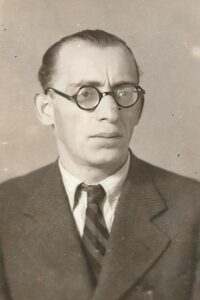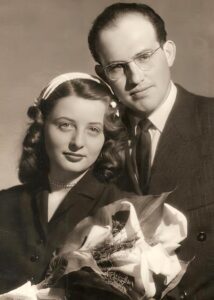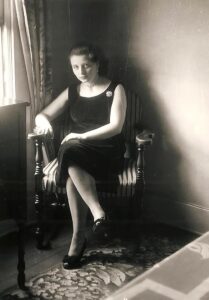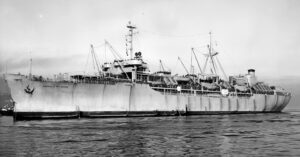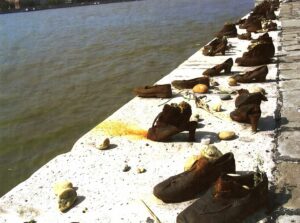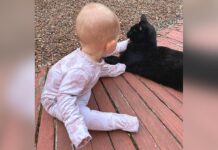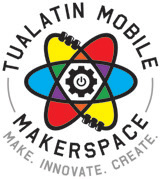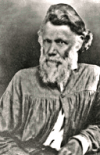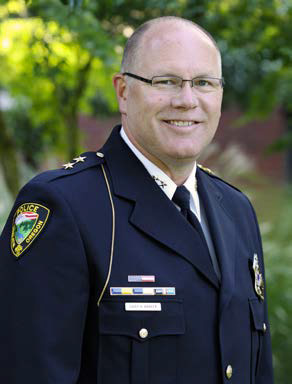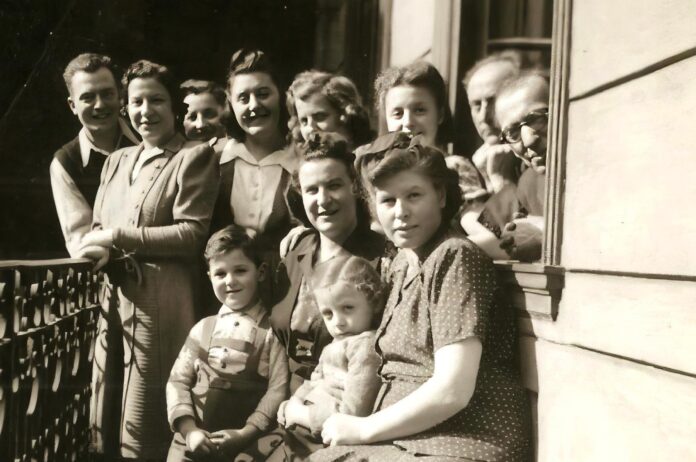
Eva Aigner credits the kindness of strangers for being alive today, such as the Hungarian Arrowcross guard who allowed her mother to rescue her and her sister out of a line of people waiting to be shot at the Danube River, or the Hungarian farmer near the Hungarian-Austrian border who traded white sheets for their few valuables so they could disguise themselves when they were escaping in the snow from a communist dictatorship and the Soviet troops in 1956.
As a young child in Hungary, Eva and her family, who were Jewish, were swept up in the Holocaust, barely surviving before being liberated. Luck was again on her side when she met and married fellow Holocaust survivor Les; and fortune shined on them again when they immigrated to the United States, arriving in Portland on Feb. 8, 1957, “with $5 in our pocket,” she said.
“I feel thankful that as refugees and Holocaust survivors, we came here and created a beautiful life and families,” said Eva, who has two children, four grandchildren and two great-grandchildren. “You can add up how many people were saved because of one man (who let them leave the line of people waiting to be shot). I wish I knew who he was. All of those people are alive because of him.”
Eva, a Tualatin resident, has many prized possessions gathered throughout her life, including an American flag that flew over the U.S. Capitol in honor of the Aigners’ contributions to the U.S. Sadly, Les died 1 1/2 years ago after 65 years of marriage.
Growing up, Eva’s family spoke Hungarian although she noted that since they lived along the border with Czechoslovakia, “the border changed all the time.” Eva was born in 1937 and had a sister eight years older. Her dad made hats and caps, and her mom was a homemaker who also helped her husband with his business. “My family loved me,” she said. “I remember in the first grade that the Hungarian flag hung in the classroom, and we would stand up and sing the Hungarian national anthem.”
Adolf Hitler rose to power in Germany as the leader of the Nazi Party and started World War II by invading Poland in September 1939 and masterminding the Holocaust, which led to the genocide of six million Jews and five million others who did not agree with the Nazi ideals.
In 1939 the Nazis passed a law that Jews could not own a business, “and my dad’s business license was taken away,” Eva said. “Our livelihood was taken away. My dad had a brother in Budapest, who told him to move there ‘because we have no such law here.’ My mom had a sister with four children and said they had to come too.
“We found an apartment in Budapest and were OK until 1942, when my dad was inducted into a forced labor camp. Jewish men had to do hard construction work like building roads and bridges to support the military.”
Eva’s dad was killed in early 1944, “and a man who had been with him was able to get his pocket watch and escape,” Eva said. “He found my mom and gave it to her.”
She added, “Yellow stars were put on buildings where Jewish people lived. Men in the forced labor camps wore yellow arm bands, and eventually men, women and even children wore yellow stars. They started putting Jewish people into housing complexes. We had one room in an apartment, and they pushed in other families, and we shared a kitchen. I started first grade, and I knew there was a war going on and when to go the basement and cover up.”
But that was only the beginning. “Two or three months after Hitler took over, the teacher asked the Jewish children to stand up, and there were five or six or seven of us,” Eva said. “We were told we could no longer sing the national anthem. Some kids were cruel and called us bad names and threw things at us. I went home crying.
“Not long after that, I couldn’t go to school any longer. One day the Arrowcross, who were the equivalent of the Hungarian Nazis, came and told us to take what we could carry because we were leaving the building. It was chaos, and we were taken to a ghetto with a brick fence and barbed wire all around it next to the largest synagogue. There were 20 or 30 of us in a small apartment and no water or electricity. I was still a small child, and there was not enough food. We had dysentery and lice and could not get clean.”
One night in December 1944, soldiers with flashlights woke up the family. “None of us were in good condition,” Eva said. “My mom was in her mid-30s and beautiful, and they took her away. You can’t imagine how devastated we were. My sister was 15 years old then and became my mom. Two weeks later they came again and told us to leave everything behind and that we were going on a march. It was snowy and cold, and my sister grabbed the only blanket we had.
“They wanted to eliminate the old and the sick and the children, and we were in a line to be shot. They had us take off our shoes before shooting us, and we were crying and shivering. Meanwhile, my mom had been taken toward a concentration camp but escaped by jumping from a train. A German soldier (not a Nazi) was standing there, and she threw herself at him and grabbed his boots, begging him to allow her to flee to save her children back in Budapest. He let her go, and she walked at night and hid during the day and found us.
“We were in the line waiting to be shot, and my mom gave a soldier her wedding ring and said, ‘Please let these girls out of the line.’ He did, and we were taken back to the ghetto. On January 18, 1945, we were liberated by the Russian troops. The gates to the ghetto opened. We were told that we could go.”
Eva was so sick and weak that she couldn’t walk, and her mom and sister carried her for 15 or 16 blocks back to their original apartment building. Along the way they saw devastation caused by the war. A dead horse left in the street had been picked clean down to its skeleton by desperately hungry people.
“We finally got to our apartment building, and it was full of bullet holes,” Eva said. “In our apartment, in a corner, my mom found photos and our birth certificates all piled up. Other than those papers, we had nothing left.
“None of our family survived in Czechoslovakia except one cousin who was taken to Auschwitz. My mom said, ‘We lost so much, but we have each other.’ My mom tried to support us by selling heated chestnuts and popcorn on a busy street corner. She knew how to sew so later she found work in a factory sewing.”
Life was hard in Hungary. “Whatever the Nazis didn’t take, the Soviets took,” Eva said. When she was 18, she met her future husband Les on a blind date who had his own horror stories of surviving the Holocaust.
“He and his family were sent to Auschwitz,” she said. “He survived. He was 16 years old and weighed just 75 pounds when the U.S. 42nd Infantry liberated the camp. His older sister escaped from a forced labor camp and hid in the country, but his mom and younger sister were killed in the gas chambers of Auschwitz. His dad also served in a forced labor camp and managed to survive. Les and I had a lot in common regarding our background, and we understood each other and fell in love. We had a two-month courtship and got married.”
The Hungarian Revolution raged from Oct. 23 to Nov. 10, 1956, when the Hungarians revolted against the USSR’s strict policies, but the USSR ultimately suppressed the insurrection. In December Eva and Les were standing in a bread line when they overheard two men talking behind them about first getting rid of the communists and then the rest of the Jews, and the couple knew they could not stay there.
The Aigners escaped from the country on Christmas Eve along with Les’ dad and stepmother with the goal of getting to Portland, Oregon, because Les’ step-brother lived there.
“My mother and sister who was sick stayed behind,” Eva said (her mom later joined them and lived to be 84, but her sister died young after having two children). “We were in a group of 18 people with five children in the group. We were put in a barn, and our valuables were traded for white sheets and transportation to the border. Once we escaped across the border to Austria, snowcats came and took us to a school building, and from there we got to the consulate where there was a long line of people waiting to leave, and families were called up one by one.”
By that time, the quota for Hungarian refugees was filled, but fortunately President Eisenhower allowed 5,000 more refugees to emigrate if they had an American sponsor, and the Aigners luckily fell into that quota.
“We took a ship for 10 days across the Atlantic and celebrated when we reached Ellis Island,” Eva said. “We were bused to a quarantine camp in New Jersey for two weeks before taking a train to Portland. We got an apartment in Northwest Portland, and it seemed to us like Buckingham Palace.”
The following July, no one had warned them about the Fourth of July fireworks that would be set off on the national holiday. “It sounded like gunshots going off, and we thought it was a revolution,” Eva said. “We asked the apartment manager if we should go to the basement. Now it is a happy holiday.”
Eva wanted to go to cosmetology school to learn how to do hair and nails but she could not afford the $400 tuition, so she earned her tuition by painting the school with Les on the weekends and doing laundry and cleaning during the week.
While she pursued that career, Les, who had been a precision-machinist and model-maker. found work. After nearly starving to death in the concentration camps, Les had two hopes in his life, according to Eva. “He never wanted to go hungry again, and he wanted to take a vacation every year, which we did,” she said.
The couple went on to have a son and a daughter, “and our dream was for our children to have the education that we never could get,” Eva said. “We just worked very hard. We were equal partners and respected each other. We loved each other and raised a good family.
“I don’t hate Germany or the people. Hitler killed 11 million people. I can’t forgive him, but I don’t have hate in my heart. I use education to teach against discrimination.”
Although World War II and the Holocaust are among the most-documented events in history, over the decades, efforts have increased to deny the existence of the Holocaust and the murder of six million Jews. By 1989 the movement had become more prevalent, and “that made us mad,” Eva said. “We decided that we had to let people know about it and the consequences, and we started sharing our story over and over.”
Eva was a co-founder of the Oregon Holocaust Memorial in Washington Park in Portland, which was dedicated on Aug. 29, 2004, “and my husband worked on it too,” Eva said. “We went back to six killing camps, including Auschwitz, in 1998, and brought back soil from the camps to make the memorial more sacred since none of our loved ones who were murdered in the camps have a grave.
“We also testified at the Legislature in Salem for Oregon to include the Holocaust in its education curriculum, and Oregon became the 23rd state to do so. I’m not a politician or a teacher, I am just a person.”
Surrounded by Holocaust survivors, on July 16, 2019, Gov. Kate Brown signed the bill into law.

Read more and watch a Tualatin Historical Society Oral History of Eva Aigner at tualatinhistory.org/oralhistory/evaaigner

